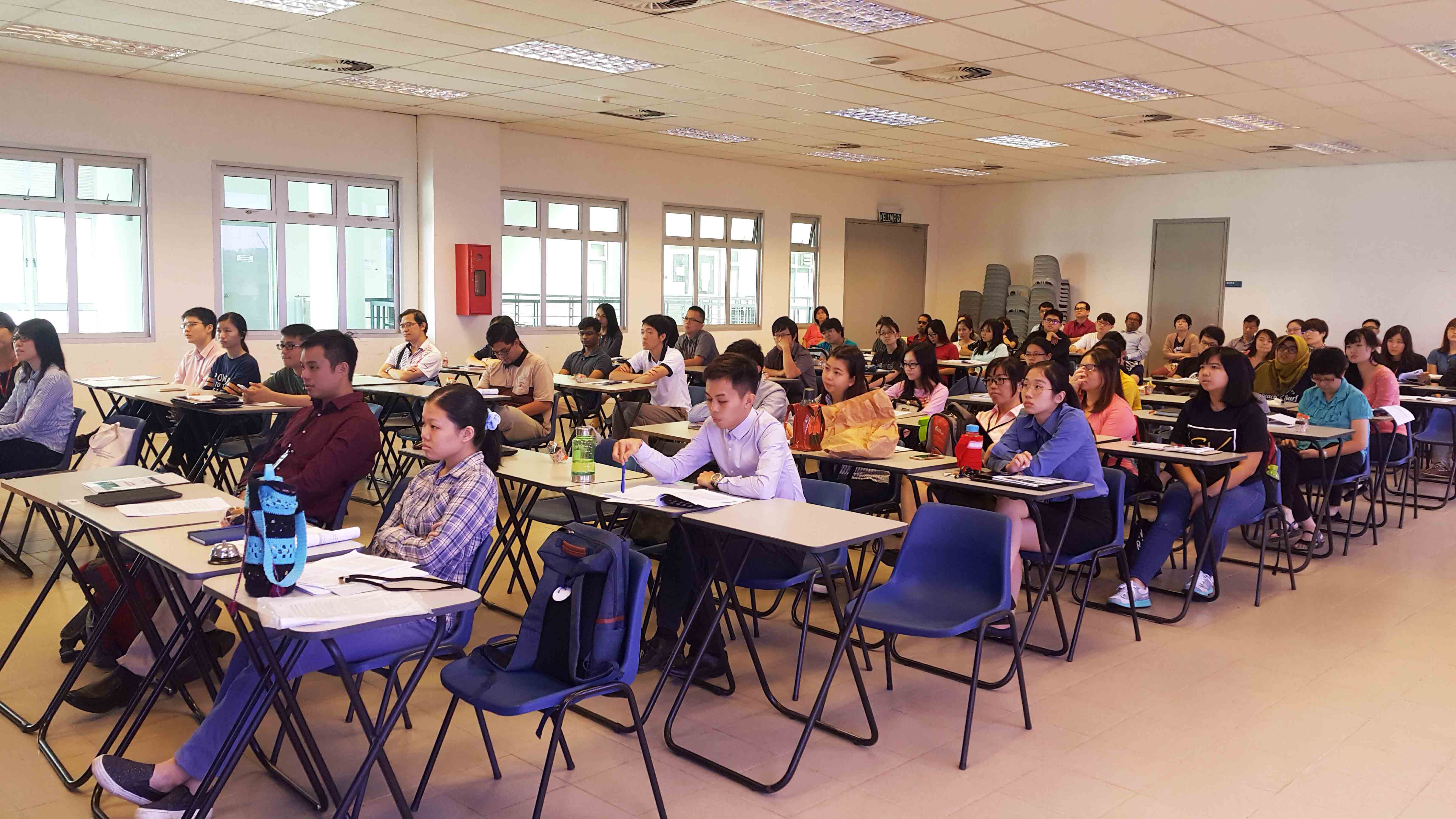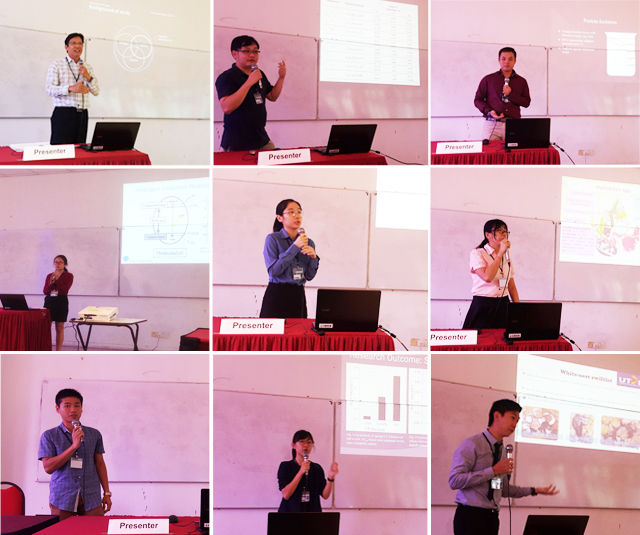

Dr Phoon (seated, third from left) and Dr Lim (seated, third from right) with staff and presenters
The Faculty of Science (FSc) held its inaugural postgraduate seminar on 14 November 2017 at the Kampar Campus, with the objectives to provide opportunities for research students to present their scholarly works; offer interaction, learning opportunities, and encourage knowledge acquisition in related field or research; and promote and develop research skills.
The seminar, which attracted 102 participations, was also attended by FSc Dean Assoc Prof Dr Lim Tuck Meng and R&D and Postgraduate Programmes Deputy Dean Dr Phoon Lee Quen. Four sessions were held, consisting of topics on Natural Products, Medical Biotechnology and Molecular Biology, Biodiversity and Ecosystem, and Chemistry, which saw invited speakers Dr Yap Moh Lan from FSc’s Department of Biological Science and FSc’s Department of Agricultural and Food Science lecturer Dr Kuan Chee Hao presented their researches.
Master of Science students, namely Quah Yixian, Law Yew Chye, Ooh Keng Fei, Ong Yen Hui, Lim Jing Wen, Siew Wei Sheng, Lim Chu Er and Choong Boon Rui as well Doctor of Philosophy (Science) student Ng Keat Chuan also presented their researches.
The first invited speaker, Dr Yap, shared her “Studies of Virus Structure by Cryo-Electron Microscopy (cryo-EM) Three Dimensional Reconstruction” research, which used cryo-EM to study the virus and its protein components, as well as their interactions with other components, such as antibodies and antiviral compounds.
By examining the virus structures in different conformations, she explained that the research provided a better understanding of the virus’ life cycle, which in return provided insights into vaccine development against viral infectious diseases.
Meanwhile, the understanding on the potential of raw vegetables transmitting and harbouring multidrug-resistant foodborne pathogens led second invited speaker Dr Kuan’s research to carry out a biosurveillance of E.coli 0157:H7, L. monocytogenes and Salmonella in raw vegetables at farm, retail and domestic kitchen level in Malaysia.
His research discovered that vegetables cleansed under running tap water with scrubbing for 60 seconds were found to be effectively cleansed from microbial population, and suggested that final rinsing and scrubbing were effective washing methods to cleaning the raw vegetables. Dr Kuan also shared findings from his research that suggested all vegetable, regardless of the farming methods, to be subjected to appropriate handling practices from farm to fork, to ensure the quality and safety of the fresh produced.
Quah hoped to be able to discover novel and specific anticancer drugs that could reduce the resistance and side effects of the drugs, through her “Antiproliferative Activities of Bioactive Peptides derived from Malaysian Marine Sponge and Soft Coral” research. Specifically guided by a cytotoxicity assay based on the human cervical cancer cell line (HeLa), the research aimed to purify and identify cytotoxic peptides from the protein hydrolysates of the giant barrel sponge (Xestospongia testudinaria) and soft coral (Sarcophyton glaucum). The results obtained highlighted the promising Malaysian marine biodiversity as a source of novel cytotoxic peptides with potential applications for future drug development.
The “Purification, Identification and Characterisation of Antioxidant Peptide from Protein Hydrolysates of Marine Sponge Xestospongia testudinaria” research by Law successfully isolated an antioxidant peptide from Xestospongia testudinaria protein isolate (XTPI) hydrolysate that has the ability to scavenge biological relevant free radicals, protect biological macromolecules from free radical damages and prevent lipid peroxidation.
With the many wetland macrophytes in Malaysia that has medicinal values and may be promising sources of various bioactive compounds, Ooh’s research on “Wetland Macrophytes: Evaluation of Bioactivities, HPLC Analysis and Isolation of Alpha-Glucosidase Inhibitor” studied four macrophytes, namely Hanguana malayana, Ludwigia adscendens, Monochoria hastate and Limnocharis flava. His study demonstrated the potential of wetland macrophytes, specifically L.adscendens, as sources of natural anti-diabetic, antioxidants, and anti-lipoxygenase agents.
Motivated by the little known facts on the defence response of dragon fruit and the expression of pathogenesis genes (PR) is yet to be elucidated, Ong’s research titled “Expression of Deduced Pathogenesis-related Protein Encoding Genes in Hylocereus undatus against Enterobacter cloacae and Neoscytalidium dimidiatum” aimed to investigate the corresponding interactions of Hylocereus undatus with Enterobacter cloacae and Neoscytalidium dimidiatum, targeting putative PR encoding genes at mRNA and protein levels over a time course in days of post-inoculation (dpi).
She shared to participants that the data collected from her research provided useful information of novel prospects about PR genes of Hylocereus spp. and their magnitude of resistance of Hylocereus undatus to infections by Enterobacter cloacae and Neoscytalidium dimidiatum.
Jing Wen’s research titled “Gene Expression of PITX2, NINJ2 and TWIST1 Genes among Ischemic Stroke Patients in Malaysia” point out to participants that people suffering from stroke either pass away or suffers permanent disabilities.
However, she mentioned that other research has suggested PITX2, NINJ2 and TWIST1 genes to be the new biomarkers for ischemic strokes, hence the aim of the project was to elucidate the gene expression patterns of PITX2, NINJ2 and TWIST1 genes among ischemic stroke patients in Malaysia.
Ng with his research titled “Fish Diversity (Chordata: Actinopterygii) as Biological Indicator for the Development and Validation of Freshwater Ecosystem Physical Visual Assessment (FEPVA) Protocol for Rating River Physical Quality” was aimed to develop an assessment protocol, namely Freshwater Ecosystem Physical Visual Assessment (FEPVA) to fill the gap.
Further research was done to identify a set if visual rating criteria and it was tested in four ecohydrological units in trial site Kampar River, Perak, and stressed that FEPVA protocol should be used in conjunction with biological and water chemistry assessments to produce balanced results to drive river management and conservation initiatives.
Siew’s research titled “Phylogenetic Relationship of House-Farmed White-Nest Swiftlets with Wild Colonies (Aves: Apodidae: Aerodramus) in Malaysia” presented to participants on the collected genetic materials across East and West Malaysia. He further explained that the research used both mitochondrial and nuclear DNA markers to reconstruct phylogenetic trees using Neighbour-Joining model and Bayesian inference. Preliminary results indicated that house-farmed swiftlets were separated into two clusters and neither one of the clusters was showing a close affinity towards the wild swiftlets.
Session four under the Chemistry topic saw Chu Er presenting her research titled “Studies of Single-Source Precursor (SSP) for Molybdenum Disulfide Nanostructures prepared by Aerosol-Assisted Chemical Vapour Deposition (AACVD)”, which aimed to prepare various MoxSy thin films, and their related surface morphologies using Scanning Electron Microscopy (SEM). Whereas for Chong, his “Synthesis and Characterisation of Ternary CO(III) Complexes containing Polypyridyl Ligand and N,O-donor Ligand” studied a series ternary Co(III) complexes containing an N,O-donor Ligand and 1,10-phenanthroline (phen).
With a closing remark by Dr Lim to mark the end of the seminar, he advised the participants to do careful planning when embarking on their postgraduate journey, to build up a culture of selective thinking, as well as to be mentally prepared for challenges.
“When you are doing your postgraduate studies, be sure to know your goals and objectives, and be clear about them. That is why you must plan ahead and plan carefully because there will be challenges present. Be disciplined, and be ready to accept if there are any unfavourable situation and find solutions that can effectively solve the problems,” advised Dr Lim.
He added, “Be sure to check your research data, re-look at your data as well so that it is substantiated with evidence. When conducting research, be consistent and check if the results are relevant to the scientific methods used.”

Participants listening attentively to the research presentations

From left: Invited speakers Dr Yap and Dr Kuan presenting their researches

Postgraduate students enlightening participants with information on
their researches
First row, from left: Ng, Chong and Law
Second row, from left: Chu Er, Jing Wen and Ong
Third row, from left: Ooh, Quah, and Siew
© 2019 UNIVERSITI TUNKU ABDUL RAHMAN DU012(A).
Wholly owned by UTAR Education Foundation Co. No. 578227-M LEGAL STATEMENT TERM OF USAGE PRIVACY NOTICE